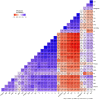Deciphering agronomic traits, biochemical components, and color in unique green-seeded fenugreek (Trigonella foenum-graecum L.) genotypes
- PMID: 40083886
- PMCID: PMC11903288
- DOI: 10.3389/fnut.2025.1542211
Deciphering agronomic traits, biochemical components, and color in unique green-seeded fenugreek (Trigonella foenum-graecum L.) genotypes
Abstract
Fenugreek is a high-value legume known for its potential to enhance human health and combat a variety of diseases and metabolic disorders. This versatile crop has demonstrated promising therapeutic effects in managing obesity, diabetes, cancer, and poor metabolism conditions that have become major global health concerns. Despite the availability of multiple pharmaceutical remedies for these ailments in the market, often times the heavy chemical doses are accompanied by side effects on human body. To investigate the agronomic traits, medicinal potential, and color of fenugreek seeds, this study was conducted and identified fenugreek genotypes with green seed color (GSF1 to GSF10), which can prevent the progression of aforementioned diseases without the hassle of side effects. Ten unique green-seeded fenugreek (GSF) genotypes were compared with five released varieties (yellow-seeded fenugreek; YSF1 to YSF5) as check. The genotypes were assessed during rabi season for 3 consecutive years (2021-22 to 2023-24) in semi-arid Eastern Plain Zone of Rajasthan, India. The findings exhibited that agronomically GSF performed well, almost at par with the YSF. Harvest index (23.21 ± 0.37%) is higher in GSF with very marginal differences in other agronomic traits. The medicinal potential of the GSF showed that GSF6 has nearly 1.5 to 2 times higher insulinotropic 4-hydroxyisoleucine (0.90%) levels compared to the YSF genotypes. This unique non-protein branched amino acid is found in fenugreek seeds. GSF1 has a high concentration of chlorophyll (0.45 mg/100 g), GSF10 has low diosgenin and high 4-OHIle (261.80 mg/100 g and 0.85%, respectively), and GSF9 has low total soluble sugars (TSS; 3.50%). Oil content, phenols, and proteins were found to be higher in GSF making it preferable over YSF. The study further revealed that darkness of green color in the seed is directly related to its chlorophyll content and is directly associated with higher content of 4-OHIle and lower TSS. Among the studied genotypes, harvest index is higher in green-seeded genotypes with maximum seed yield (2473.74 Kg/ha) in genotype GSF8. The superior genotypes GSF1, GSF6, GSF8, GSF9, and GSF10 developed in the study hold potential for future breeding initiatives, aimed at boosting medicinal value, nutritional quality, and productivity.
Keywords: PCA; cancer; harvest index; insulin-resistance; medicinal; obesity; seed color.
Copyright © 2025 Singh, Meena, Choudhary, Meena, Meena, Verma, Mahatma, Yathendranaik, Lal, Shekhawat and Bhardwaj.
Conflict of interest statement
The authors declare that the research was conducted in the absence of any commercial or financial relationships that could be construed as a potential conflict of interest.
Figures









Similar articles
-
Performance of some Ethiopian fenugreek (Trigonella foenum-graecum L.) germplasm collections as compared with the commercial variety Challa.Pak J Biol Sci. 2012 May 1;15(9):426-36. doi: 10.3923/pjbs.2012.426.436. Pak J Biol Sci. 2012. PMID: 24163952
-
Biochemical monitoring in fenugreek to develop functional food and medicinal plant variants.N Biotechnol. 2011 Feb 28;28(2):110-7. doi: 10.1016/j.nbt.2010.09.001. Epub 2010 Sep 22. N Biotechnol. 2011. PMID: 20851781
-
Comparison of ultrasound and microwave assisted extraction of diosgenin from Trigonella foenum graceum seed.Ultrason Sonochem. 2021 Jun;74:105572. doi: 10.1016/j.ultsonch.2021.105572. Epub 2021 Apr 22. Ultrason Sonochem. 2021. PMID: 33933831 Free PMC article.
-
4-Hydroxyisoleucine from Fenugreek (Trigonella foenum-graecum): Effects on Insulin Resistance Associated with Obesity.Molecules. 2016 Nov 22;21(11):1596. doi: 10.3390/molecules21111596. Molecules. 2016. PMID: 27879673 Free PMC article. Review.
-
Revisiting Trigonella foenum-graecum L.: Pharmacology and Therapeutic Potentialities.Plants (Basel). 2022 May 29;11(11):1450. doi: 10.3390/plants11111450. Plants (Basel). 2022. PMID: 35684222 Free PMC article. Review.
Cited by
-
Characterization of bioactive compounds in fenugreek genotypes in varying environments: diosgenin, trigonelline, and 4-hydroxyisoleucine.Front Plant Sci. 2025 Mar 24;16:1562931. doi: 10.3389/fpls.2025.1562931. eCollection 2025. Front Plant Sci. 2025. PMID: 40196427 Free PMC article.
References
-
- Najafi S, Anakhatoon EZ, Avci BM. Karyotype characterisation of reputed variety of fenugreek (Trigonella foenum-graecum) in West Azerbaijan-Iran. J Appl Biol Sci. (2013) 7:31–4.
-
- Altuntaş E, Özgöz E, Taşer ÖF. Some physical properties of fenugreek (Trigonella foenum-graceum L.) seeds. J Food Eng. (2005) 71:37–43. doi: 10.1016/j.jfoodeng.2004.10.015 - DOI
-
- Choudhary S, Singh R, Ravi Y, Gena CB, Singh D, Harisha CB, et al. . Phytotherapeutic, Nutraceutical, Medicinal, and forage properties of fenugreek (Trigonella foenumgraecum L.): a comprehensive review. J Adv Biol Biotechnol. (2024) 27:719–33. doi: 10.9734/jabb/2024/v27i101494 - DOI
-
- Srinivasan K. Fenugreek (Trigonella foenum-graecum): a review of health beneficial physiological effects. Food Rev Int. (2006) 22:203–24. doi: 10.1080/87559120600586315 - DOI
LinkOut - more resources
Full Text Sources

